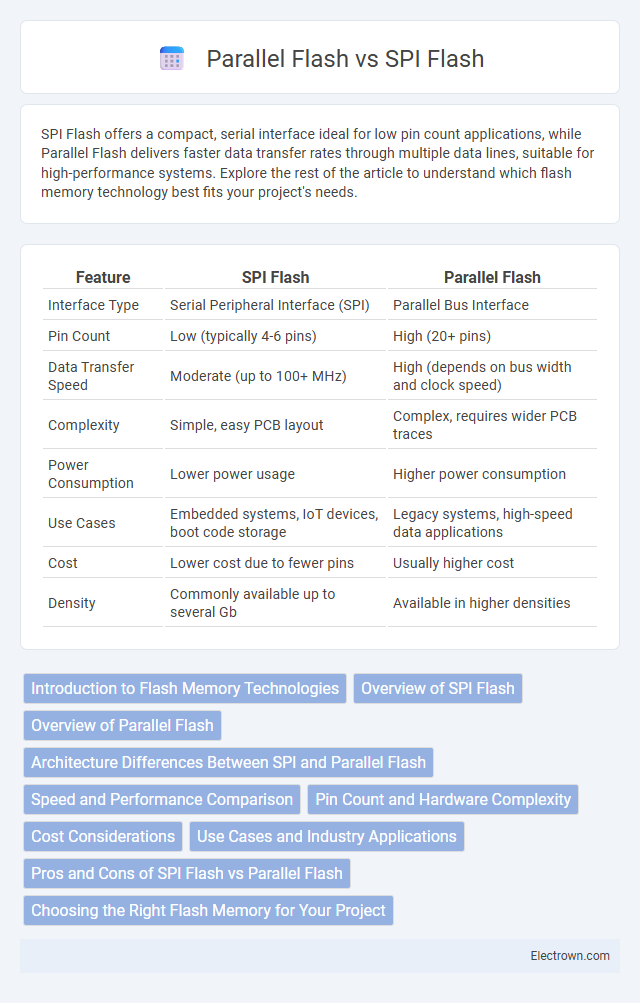SPI Flash offers a compact, serial interface ideal for low pin count applications, while Parallel Flash delivers faster data transfer rates through multiple data lines, suitable for high-performance systems. Explore the rest of the article to understand which flash memory technology best fits your project's needs.
Table of Comparison
| Feature | SPI Flash | Parallel Flash |
|---|---|---|
| Interface Type | Serial Peripheral Interface (SPI) | Parallel Bus Interface |
| Pin Count | Low (typically 4-6 pins) | High (20+ pins) |
| Data Transfer Speed | Moderate (up to 100+ MHz) | High (depends on bus width and clock speed) |
| Complexity | Simple, easy PCB layout | Complex, requires wider PCB traces |
| Power Consumption | Lower power usage | Higher power consumption |
| Use Cases | Embedded systems, IoT devices, boot code storage | Legacy systems, high-speed data applications |
| Cost | Lower cost due to fewer pins | Usually higher cost |
| Density | Commonly available up to several Gb | Available in higher densities |
Introduction to Flash Memory Technologies
Flash memory technologies, including SPI Flash and Parallel Flash, serve as crucial non-volatile storage solutions in electronics. SPI Flash offers serial communication with smaller pin counts and lower power consumption, ideal for compact and cost-sensitive applications. Parallel Flash provides faster data transfer rates through multiple data lines, making it suitable for high-performance systems where speed is essential for your data processing needs.
Overview of SPI Flash
SPI Flash is a type of non-volatile memory that uses a Serial Peripheral Interface to communicate, offering simplicity and lower pin count compared to Parallel Flash. It typically provides slower data transfer rates but excels in applications requiring compact design and reduced power consumption. Your choice of SPI Flash is ideal for embedded systems where board space and efficiency are critical.
Overview of Parallel Flash
Parallel Flash memory features multiple data lines enabling simultaneous data transfer, resulting in faster read and write speeds compared to serial interfaces like SPI Flash. It typically uses an 8-bit or 16-bit wide data bus, which increases throughput for applications requiring rapid access to large volumes of data. Commonly employed in embedded systems and consumer electronics, Parallel Flash offers lower latency but demands more pins and board space in hardware design.
Architecture Differences Between SPI and Parallel Flash
SPI Flash employs a serial communication interface using fewer pins, typically four or six, enabling simpler PCB layout and lower cost, while Parallel Flash uses multiple data lines (often 8, 16, or 32 bits) for simultaneous data transfer, resulting in higher throughput but increased pin count and board complexity. SPI Flash's architecture relies on a clock signal to synchronize data transmission bit-by-bit, making it well-suited for compact devices with limited I/O, whereas Parallel Flash communicates data in byte-wide or word-wide chunks directly to the microcontroller or processor. Understanding these architecture differences helps you select the right flash memory based on your application's speed requirements, system complexity, and space constraints.
Speed and Performance Comparison
SPI Flash offers slower data transfer rates, typically up to 100 MB/s, due to its serial interface design, making it suitable for low to moderate speed applications. Parallel Flash, with its multiple data lines, enables faster data throughput often exceeding 200 MB/s, delivering superior performance for high-speed memory requirements. Your choice between SPI Flash and Parallel Flash directly impacts system speed, where Parallel Flash favors applications demanding quicker read/write operations.
Pin Count and Hardware Complexity
SPI Flash typically features a lower pin count, often requiring only four to six pins, which simplifies your hardware design and reduces PCB space. Parallel Flash demands more pins, usually ranging from 16 to 32, increasing the complexity of routing and the overall hardware footprint. Choosing SPI Flash can streamline circuit layout and minimize interface complexity, making it ideal for applications with limited board space.
Cost Considerations
SPI Flash offers lower costs due to its simpler serial interface and reduced pin count, making it ideal for budget-sensitive applications and space-constrained designs. Parallel Flash typically incurs higher expenses because of its complex interface and greater number of pins, which increase PCB complexity and manufacturing costs. Choosing between SPI and Parallel Flash often hinges on balancing cost against performance requirements and system design constraints.
Use Cases and Industry Applications
SPI Flash memory is ideal for embedded systems, consumer electronics, and IoT devices due to its low pin count, cost-effectiveness, and ease of integration, making it suitable for firmware storage and small data logging. Parallel Flash excels in automotive, aerospace, and industrial applications requiring high-speed data access and large storage capacity, such as firmware updates and real-time data processing. Your choice between SPI and Parallel Flash depends on the required memory speed, capacity, and system complexity in your specific industry application.
Pros and Cons of SPI Flash vs Parallel Flash
SPI Flash offers advantages such as simpler PCB design, lower pin count, and cost-effectiveness, making it ideal for compact, power-sensitive applications. However, it generally has slower data transfer rates and higher latency compared to Parallel Flash, which provides faster read/write speeds and is suited for high-performance needs but requires more complex circuitry and higher pin count. The choice depends on balancing speed requirements against design complexity and cost constraints in embedded system applications.
Choosing the Right Flash Memory for Your Project
Choosing the right flash memory for your project depends on speed, pin count, and system complexity. SPI Flash offers a lower pin count and simpler interface, ideal for space-constrained designs requiring moderate speed and easy integration. Parallel Flash provides higher data throughput and faster access times, making it suitable for applications demanding rapid read/write operations and larger memory capacities.
SPI Flash vs Parallel Flash Infographic

 electrown.com
electrown.com